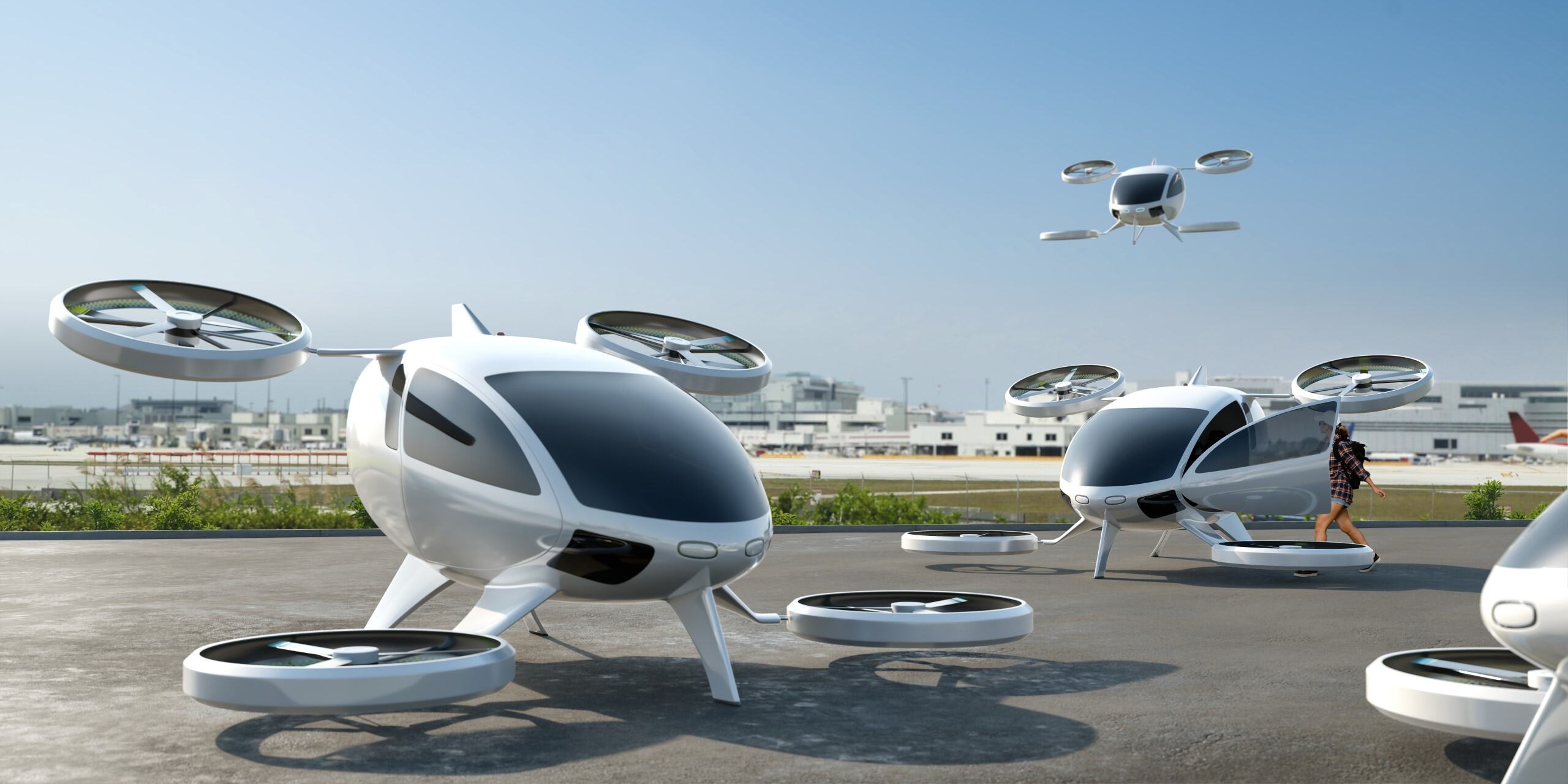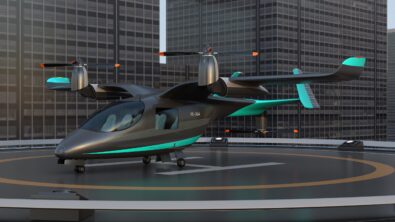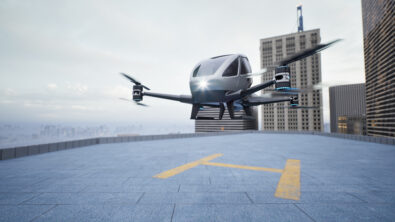Building George Jetson’s Car Part One – Transcript

In this episode of Talking Aerospace Today, Todd Tuthill kicks off a new arc exploring the burgeoning advanced air mobility sector, what challenges companies working in AAM should expect to face, and how digital transformation can play a role in overcoming them.
Patty Russo: Greetings, and welcome to Talking Aerospace Today from Siemens Digital Industries Software. I’m Patty Russo and I’m responsible for the aerospace and defense marketing vertical here at Siemens. Thank you so much for listening. Today we’re beginning a new arc and we’ll be covering topics around a new and interesting area, advanced air mobility, also known as AAM.
Patty Russo: We’re all aware of the flying cars from the iconic TV cartoon series, The Jetsons. Some of you might be humming that theme song in your minds. While we still lack any sort of anti-gravity technology, recent developments in AAM are bringing that aspect of the future, closer to the present. Some of the things that we’re going to talk about in this arc are things like what will it take to bring George Jetson’s car to life? What are the challenges that companies in this AAM market will be facing?
Patty Russo: What solutions to these challenges do digital transformation solutions offer? Other questions like that that I’m sure there are many, so these are just a few that we’ll be exploring and answering in this upcoming series. Let’s dive right in and we’ll begin by introducing Todd Tuthill, our Vice President of Aerospace and defense for Siemens Digital Industries Software. Welcome again, Todd.
Todd Tuthill: Thank you, Patty. Great to be here. And full disclosure for all our listeners, I really, really wanted to use the George Jetson theme song for this podcast, but we just couldn’t get the licensing rights for it. So you’ll all have to hum along yourself. You know, I’d sing it now, but first off, you don’t want to hear me sing. And second off, I don’t want to get this banned for copyright violations. But we all know the theme song. “Meet George Jetson, Jane his wife,” right? And Astro, I think was his dog. Man, this is going to be fun. Been looking at this for a long time. Let’s get into it, Patty.
Patty Russo: Let’s do. Yeah. You hit the nail on the head with that. I thought I’d give a nod to your desire for the song. So I always like to start with context, whether it’s a podcast or even just a conversation. So in this case, context for myself and our listeners. So before we dive deep, let’s first go high-level and define what AAM is. How would you describe advanced air mobility, Todd?
Todd Tuthill: OK, so let’s start with maybe the drier stuff. Let’s define a few terms. AAM is advanced air mobility. We’ll talk about that. There’s a subclass of AAM called UAM, which is urban air mobility. Advanced air mobility is this exciting new class of aircraft. Typically electrically powered, typically using multiple rotor blades that can take off and land in close, usually urban places and the close to buildings, things we haven’t traditionally been able to do. Again, advanced air mobility is this broad class of vehicles. Some of them carry people. That’s urban air mobility type, and some of them are just drones. Everything from the DJI drone I have sitting on the table behind me here up to much larger drones that can carry cargo, can be used for photography.
Todd Tuthill: All those kinds of things and, you know, you can see now I think that they’re already being used to deliver Amazon packages and pizzas. So it’s kind of that whole class, but most of the time when we talk about advanced air mobility, we’re really focused on that UAM of that urban air mobility, this class of vehicle that maybe holds two to six passengers, two to six people, and flies around in urban airspace. Now that’s the generic part. Let’s talk about the fun part of what AAM holds, or UAM holds for us because let’s dream a little bit.
Todd Tuthill: Let’s talk about what life in our society in 2030 and 2035 is going to be like. And to tell the story, I want to start back. I think I was in Phoenix about a month ago. Phoenix, Arizona. I live here in Tucson, not far from Phoenix, and I was driving. My wife and I were driving down the street and I said, “Look! that’s an autonomous Uber!” Just driving down, the car driving down the street with people in it and nobody driving it. I said, “That’s really cool!”
Todd Tuthill: And I, you know, I heard about them, seeing them. I don’t know if I’d seen one in real life until about a month ago and that’s the promise that we’re talking about by 2030, because right now you can go to cities like Phoenix and other large cities, maybe Austin, can pull out your Uber app and you may end up with an autonomous car to drive you around. By 2030, we’re going to be able to pull out our Uber app and an option isn’t going to just be Uber XL, Uber black.
Todd Tuthill: There’s going to be an option there called Uber Air in some of our big cities and we’re going to be able to pay for and contract a flying car essentially like we said, you know, the dream of George Jetson to come take us from where we’re at in the downtown major city, maybe to an airport and make that trip in five or 10 minutes instead of spending an hour and a half in traffic in some of those things. that’s the promise of 2030. I would predict some large cities are going to have some access to that by 2030, but by 2035, I think you’re going to see this kind of technology become far more ubiquitous, and it’s going to be used more than just a simple flight to the airport, but we’re going to see it used in lots of areas, and that’s what’s so exciting to me.
Todd Tuthill: And it’s this whole new class of aerospace, you know, how often in our lives do we get to experience something, brand new technology that we all get to use? And that’s the promise of urban air mobility, advanced air mobility, that we’re really going to explore in the arc of this podcast.
Patty Russo: So giving us lots more flexible options for transporting people and things to and from, regardless of whether it’s in a city or between cities or even countries eventually. So really cool stuff. Let’s talk a little bit now about the industry, the AAM, I guess, sector of the industry and I’m curious and I’m trying to figure out how to ask this question the right way because those in the audience, some are full in, all in, and know, you know, a lot, I’m sure a lot more than I do about this area of the industry. Some are more novices. So let’s, at a high-level, talk a little bit, if you could, Todd, about how advanced air mobility craft or vehicles differ from traditional aircraft and air vehicles beyond the obvious.
Todd Tuthill: Great question and I’ll focus on the vehicles that I think will be around by 2030, 2035. We’ll focus on the next eight to ten years, maybe. And there’s lots of similarities, you’ll see similarities to general aviation aircraft in that they carry just a few people, but very different than like a 737 that’s going to carry 150 people. But one of the primary differences, and you’ll see similarities to helicopters because they can land and take off vertically as opposed to fixed wing aircraft, that need a runway, so that’s a couple of differences. But the real one of the real key differences is in the propulsion system.
Todd Tuthill: Advanced air mobility aircraft are not always, but almost always, they’re being designed as electric. They’re battery powered as opposed to the fossil fuel used to power jet engines or piston driven engines that we find in almost all general aviation, helicopter, commercial aircraft today. Which makes advanced air mobility aircraft green, assuming that when the electricity was produced, it was produced in a green way, they become green and sustainable.
Todd Tuthill: But another real benefit is that they’re far quieter. If anybody’s ever been around a helicopter and you feel all the air and all the noise and all that stuff, and how noisy a helicopter is, you know, if we think about filling the skies in a major city, you know, with the orders of magnitude more helicopters, that’d be noise pollution. Nobody wants that. So one of the key driving benefits of AM’s is that they’re far, far quieter. And as I said, you know the Advanced Air mobility aircraft don’t need a runway, and then you say some of the advanced air mobility aircraft being produced now like the one by Wisk doesn’t even have a pilot. It’s fully autonomous.
Todd Tuthill: A number of the other ones being produced by companies like Archer and Joby and Volocopter and Lilium, they’re all going to initially be piloted, but I think eventually we’re going to see most, all advanced air mobility aircraft go to that autonomous, pilotless function. So that’s just some of the differences between advanced air mobility and the aircraft we all traditionally think about now.
Patty Russo: So based on those differences, I would suspect a lot of the considerations that companies that are in this space, they face considerations around some of the same sustainability issues that all, you know, that all industries, all companies are faced with today. What are some of the considerations and as far as design, do companies need to consider when they’re building or designing aircraft for the AAM market?
Todd Tuthill: Okay, so design or challenges in design I think is what you’re asking me. I’ll talk about four. Okay, let’s talk about autonomy, range, infrastructure, and certification. We’ll talk about them in that order. So it, as I said before, we’ve got the company Wisk. Their Gen 6 aircraft, that they said should be certified by the end of the decade, certified by the FAA to carry paying passengers, that is fully autonomous from the beginning.
Todd Tuthill: So imagine that. Just like, you know, that car I saw in Phoenix was autonomous and passengers got in and drove them around without a driver, Wisk is saying by the end of the decade they’re going to have an autonomous Gen 6 version of the aircraft that will fly, pick you up, take you where you want to go without a pilot in it, and there’s real technological challenges to be overcome from a safety standpoint. Especially what does it take, what kind of redundancies does it take to do that?
Todd Tuthill: And I heard the CEO of Wisk on a podcast recently. He was talking about this whole idea of command and control. If you think about most of, let’s say for instance, the DJI drone I have behind me right now. I have a controller and while I’m not flying it in terms of giving it all the commands, I’m constantly commanding it telling it where to go and if the connection to the controller is lost, my TJI drone has no idea where to go. It’ll eventually, you know, it could run out of battery power and crash. Well if you’re going to put people in an aircraft like that, that’s unacceptable.
Todd Tuthill: So one of the key technologies is not just the autonomous nature of flying the aircraft around, but the safety nature of what happens when that command and control link fails. And there’s all kinds of interesting technologies and interesting challenges that need to be taken care of to overcome autonomy and also just a social aspect, of convincing people to get into an aircraft without a pilot. And Wisk has incredible technology and innovative ways that they’re solving those problems.
Todd Tuthill: So thing one is autonomy. Thing two is range. Most of the AAMs that we’re talking about right now are limited to 100 miles or less and that’s because of something called the energy density of batteries. These AAM’s are all electric. They’ve all got to carry batteries on board and there’s a limit to the size that you want to make these aircraft and how much these aircraft we want to weigh in terms of performance
Todd Tuthill: And the more batteries you put in there, the heavier they get, and it becomes a self-defeating thing. And there’s a sweet spot for range, most companies said that’s around 100 miles. I’m concerned that it’s going to be pretty difficult for these things to be profitable in the long run with that kind of range and as often as it is going to be recharged. I think we’re going to need to see the energy density of batteries almost double to get the kind of range and performance that these aircraft are going to need, especially in colder climates to do all the things that they need to do.
Todd Tuthill: So range is the second thing, the third thing is infrastructure. Where all these things going to land? You know, they don’t need a runway. I saw some of these vehicles live in in person last year at the Paris Air Show. And we talk about flying cars and we think about something about the size of a car. That’s really not what these are. These are closer to the size of like a Cessna kind of an aircraft because they have, most of them have wings and rotors and it was kind of overwhelming to me at first when I saw it because I realized this thing can’t come land in my front yard. Can’t fly around power lines. They need places to land, and those places are going to be called vertiports. It’s these things that need to be built. A lot of these vertical ports are planning to be built on, we’re thinking about things like the tops of buildings and the tops of parking garages around areas like that. So vertiports. That’s one aspect in infrastructure.
Todd Tuthill: Another aspect of infrastructure is where is all the power going to come from? Where do we get all the electricity? There are states like California that are being to mandate electric powered cars and electric powered vehicles. And if you think about the strain that’s going to put on our electrical grid, these aircraft are just going to put that much more strain on this electrical grid if they become ubiquitous. So where are we going to produce all this power? How’s it going to be green? How will we get power to, there’s a large amount of electrical power to these vertical ports So infrastructure is the third issue. The fourth issue is certification.
Todd Tuthill: Certification, type cert by the FAA for this whole new class of aircraft and there’s all these new rules around certification and all these new rules and laws and technology around how will these aircraft, especially when they’re autonomous, how will they work in congested airspace along with manned aircraft, with real air traffic controllers? You know, how will air traffic controllers talk with and communicate with and give commands to autonomous aircraft? If that autonomous aircraft goes down and makes a mistake, who’s at fault and where’s the liability? So there’s certification and legal issues to be overcome too.
Todd Tuthill: And again, all these things are solvable, and to me they’re very interesting, but they’re certainly four things we have to think about and overcome for this cool new class of aircraft to become ubiquitous and profitable, and a part of everyday life.
Patty Russo: To move cool new technology from the exception to the rule or ubiquity and profitability, it always involves overcoming new challenges. And no doubt we’ll be addressing some of those challenges and how to address them in future episodes. But for now, it’s time to wrap up this episode. We’ll be back next time to conclude this introduction to advanced air mobility. Todd, thank you for your insights and expertise, and thanks to our listeners for joining us. We hope everyone’s learned something new today, and we’ll look for you on the next episode of Talking Aerospace Today.
Siemens Digital Industries Software helps organizations of all sizes digitally transform using software, hardware and services from the Siemens Xcelerator business platform. Siemens’ software and the comprehensive digital twin enable companies to optimize their design, engineering and manufacturing processes to turn today’s ideas into the sustainable products of the future. From chips to entire systems, from product to process, across all industries. Siemens Digital Industries Software – Accelerating transformation.


